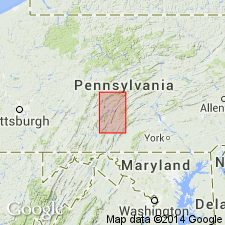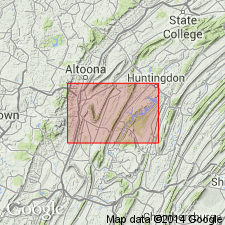
- Usage in publication:
-
- Allegrippus conglomerate
- Modifications:
-
- Original reference
- Dominant lithology:
-
- Conglomerate
- AAPG geologic province:
-
- Appalachian basin
Summary:
Pg. 99-100. Allegrippus conglomerate. White quartz pebbles in matrix of grayish white sand. Thickness 5 to 10 feet. Forms Allegrippus [Allegrippis] Ridge, Huntingdon County, central Pennsylvania. Overlain by olive shales and thin sandstone, and underlain by 450 feet of shales, all belonging to Chemung formation. [Age is Late Devonian.]
Source: US geologic names lexicon (USGS Bull. 896, p. 34).

- Usage in publication:
-
- Allegrippis sandstone member*
- Modifications:
-
- Revised
- Dominant lithology:
-
- Sandstone
- AAPG geologic province:
-
- Appalachian basin
Summary:
Pg. 12, pls. (Huntingdon quadrangle). Allegrippis sandstone member of Chemung formation. Three sandstones separated by shale; thickness 77 feet (section 5, near Saxton). Generally, it is a greenish-gray sandstone, weathering white, but locally is a coarse conglomerate and commonly has layers or pockets of conglomeratic sandstone. Occurs about 1,400 feet above Piney Ridge sandstone member of Chemung, and a considerable distance below Saxton conglomerate member of Chemung. Age is Late Devonian.
Source: Publication; US geologic names lexicons (USGS Bull. 896, p. 34; USGS Bull. 1200, p. 55).
For more information, please contact Nancy Stamm, Geologic Names Committee Secretary.
Asterisk (*) indicates published by U.S. Geological Survey authors.
"No current usage" (†) implies that a name has been abandoned or has fallen into disuse. Former usage and, if known, replacement name given in parentheses ( ).
Slash (/) indicates name conflicts with nomenclatural guidelines (CSN, 1933; ACSN, 1961, 1970; NACSN, 1983, 2005, 2021). May be explained within brackets ([ ]).

